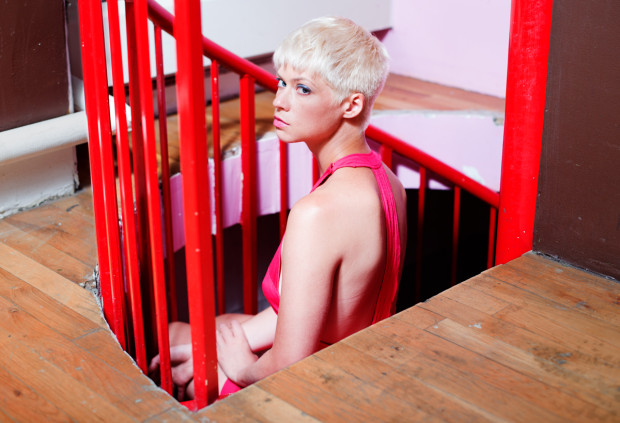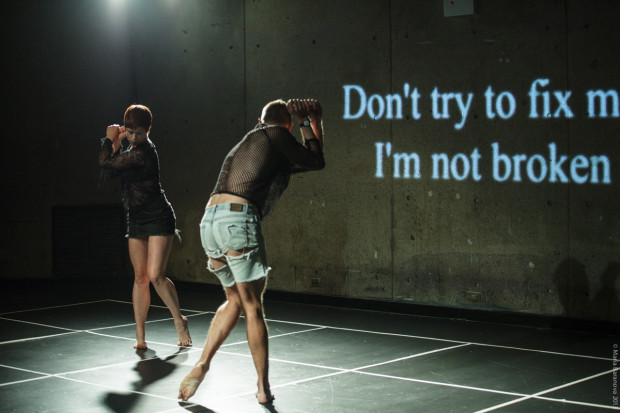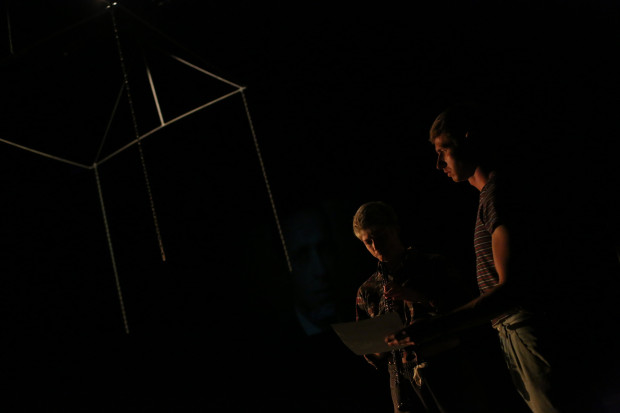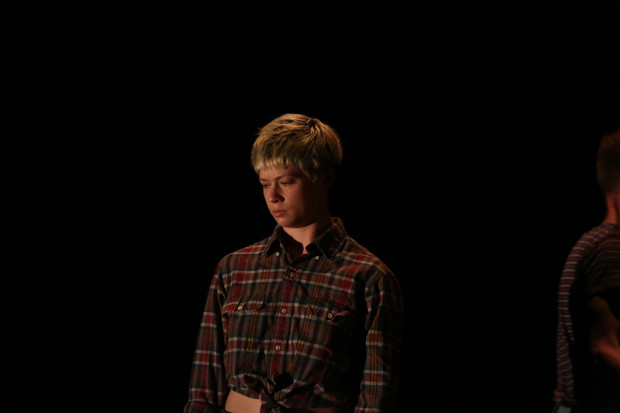
Rebecca Patek. Image courtesy of Marsha Owett
[Editor’s note: This week and next we’ll be featuring the work of seven artists we think you should keep an eye on. Not only are they making extraordinary work, but they’re being recognized for it as well.]
In the world of performance, breaking taboos and celebrating cliches is tricky business; social and aesthetic mores exist for a reason, and in breaking them, it’s easy to piss people off. You have to be okay doing that.
At this point, we can only assume choreographer and performance artist Rebecca Patek has made her peace with that risk. Her satirical performances designed to make audiences uncomfortable have been lauded by The Brooklyn Rail, Art F City and Timeout New York, panned by the New York Times, and trolled by notorious performance artist Ann Liv Young.
In our estimation, though, anyone who has watched Rebecca Patek’s work and dismissed it isn’t paying attention. Her January 2014 performance “ineter(a)nal f/ear” was an intense portrayal of psychological experience of rape that surgically picked apart the ways we package artists, and their experiences, into something we can consume. It was inarguably the most thoughtful and uncomfortable performance we have ever seen in a theatre.
We couldn’t have been the only ones who noticed; it’s hard to name a dancer and choreographer in New York who performs as much as Patek. Over the course of the last two years, she presented work at The Kitchen, Triple Canopy, Josee Bienvenu Gallery The 92 Street Y, The Abrons Art Center and pretty much every other alternative space you could name. Then she won a 2014 Brooklyn Arts Exchange Space Grant and has been commissioned by the Chocolate Factory and the Abrons Art Center next May to produce a new work .
We know some of this because, disclaimer, Patek rented a living space shared with the Art F City office last year. We’ve watched her star rise. But we’ve also watched her performances, and that’s why she’s on this list.
What defines a good artist?
I’m not entirely sure what makes a good artist other than making good art. When I see art I really like, usually it is when I can tell the work is larger than the person making it—meaning the piece produced contains its own logic and its own need— and it takes over the artist completely. It becomes the primary concern—not what is good, right, or even what is necessarily in the best interest of the artist.
Who and what are your influences and why?
I am influenced a lot by just living. The absurdity of our situation as conscious beings. I am influenced by my time in the dance world and my time spent watching Monty Python and sketch comedy as a kid. I am influenced as well by growing up alone in the woods.
Are you a feminist? Do you think that’s a relevant term for describing your work?
Yes. I am a feminist. I am not sure if I am making feminist work or just work that describes my experience as a female in the world. (Maybe this is the same thing given our lack of female perspectives and protagonists?) But, also, I don’t really want to know anyone or see anyone’s work who would not by now call themselves a feminist. You are either a feminist or a misogynist at this point in time.
“Ineter(a)nal f/ear”was an intense portrayal of the psychological experience of rape. The piece surgically picked apart the ways we package artists, and their experiences, into something we can consume—and then you tore all of that down with actual live sex. Do you think the art-i-fying of trauma kind of packages reality in a way that can be enjoyed from a safe distance?
I am not sure if there can ever be a safe distance from things. We feel things whatever the context. We want to understand and deal with the things we experience and through a process of assimilation create patterns that can give meaning to what otherwise seems meaningless futile and cruel. I have never understood the human capacity for violence; the need to understand what seems incomprehensible was the center of that piece.
What is your process like? How do you develop a piece like that?
In that work I started from the stories. But instead of approaching them as a simple narrative I decided to focus on the internal narrative—the psychological story—which is frequently untold and unacknowledged even to the self. I decided to apply that same process in the aesthetic narrative of the piece: going through different cliches in the art/performance world, pop culture, language, as well as character and gender stereotypes. I was also really interested in the parallel between moral “wrongness” and aesthetic wrongness and how that connects with how we see ourselves and others.
The work seems to draw from a variety of backgrounds—dance, experimental theater, art—and from all different aspects of life. I remember you obsessing over a particular brand of alarm clock as a prop. Is it possible to relax when everything is a potential source of inspiration?
I have trouble knowing how to stop working or obsessing when I’m working on a piece. My life can sometimes become like a long rehearsal. It is like searching for an answer to a riddle. Basically I can’t stop obsessing until it reveals itself and tells what it wants or needs me to do for it to come into a realized form.
Do you see yourself living in New York for the next five to ten years?
Yes. Hopefully the rent doesn’t keep going up exponentially.

Rebecca Patek, “Ineter(a)nal F/ear.” Performance at Abrons Art Center during Festival TBD: Emergency Glitter. Photo: Maria Baranova

Rebecca Patek, “Ineter(a)nal F/ear.” Performance at Abrons Art Center during Festival TBD: Emergency Glitter. Photo: Maria Baranova

Rebecca Patek, “I Heard it was Alright(pause for two seconds), I Mean(pause for one second) I am Curious to See Where it Goes.” Performance, June 6-7th, at The Kitchen. Photo: ©PaulaCourt. Courtesy of The Kitchen

Rebecca Patek, “I Heard it was Alright(pause for two seconds), I Mean(pause for one second) I am Curious to See Where it Goes.” Performance, June 6-7th, at The Kitchen. Photo: ©PaulaCourt. Courtesy of The Kitchen




Comments on this entry are closed.